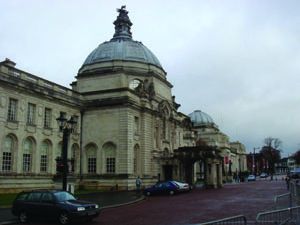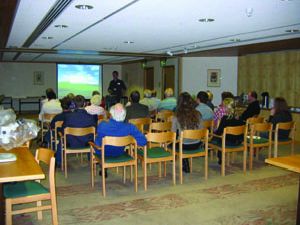|
A Conchological Society symposium was held at Amgueddfa Cymru - National Museum Wales in Cardiff, 15-16 November 2008, and organised by Ben Rowson: there were 26 participants. Lecture presentations were given on both days together with two workshops and an opportunity to see and use the Melvill-Tomlin collection of shells, assisted by the Collections Manager Harriet Wood. J R le B Tomlin had a long association with the museum in Cardiff that began when he was Senior Assistant Master at Llandaff Cathedral School in 1888-1899. Tomlin’s collection and conchological library, the most comprehensive in private hands in the country, came to the museum in the 1950s and Tomlin was a key figure in the British conchological world of the first half of the twentieth century. He had a long period of membership of this Society, joining in 1886, that lasted until his death in 1954. He held office as President (twice) and Editor of the Journal. Cardiff was therefore an appropriate venue for the Symposium. Britain’s Carnivorous Slugs and Snails Ben Rowson, National Museum Wales Ben Rowson has previously worked on Streptaxidae, a family of tropical carnivorous snails but this presentation investigated the British species that have adopted a carnivorous diet. Animal food is taken by the large arionid slugs and by glass snails of the family Zonitidae. Some work has been done investigating the taking of earthworms by Oxychilus. However it is in the slug family Testacellidae that the obligate carnivores are to be found. Testacella burrows underground and feeds on earthworms that are impaled by the sharp needle-like radula teeth. The brown T. maugei, has a south western distribution and is found in gardens in the Cardiff area. The other two species are more generally distributed in Britain but T. scutulum (the one with the yellow foot sole) is not well known in Wales. Another carnivorous slug, the Ghost Slug (Selenochlamys ysbryda) was first found in Cardiff in 2007. It also lives underground and eats earthworms and originates from Turkey and Georgia. Specimens (alive) were on display. It is white in colour and has no eye spots. Zebra Mussels (Dreissenia polymorpha) IN Cardiff Bay: a Case Study Muriel Alix, University College, Cardiff This is an introduced species of freshwater mussel that can give problems as it is highly invasive with its pelagic larva and can build up to high densities. It came to Britain attached to boats in the nineteenth century and it attaches with byssus threads to boats, buoys, harbour walls and pipes. The interest in studying Zebra Mussels relates to the new barrage across Cardiff Bay that has created a 200 hectare freshwater lake. A project from 2001-2003 looked at the invasion of the new habitat, recording distribution, density, biomass, life history information and also investigated their impact on plankton and oxygen levels and looked for possible deterrents. The Zebra Mussel is distributed by its pelagic larva so plankton samples were taken every two weeks around the bay in 2006-2008. These showed annual peaks in larval presence. Research took place to investigate the pattern of colonisation using artificial substrata for settlement, including some with an antifouling agent. Field work in Cardiff Bay with sonar techniques found only seven sites of suitable hard benthic substratum. Settlement rates varied being high in 2007 and low in 2008, perhaps due to the cool summer. Marine Molluscs of Caves and upper Shore Crevices Jan Light At the interface between land and sea there is Cingula trifasciata that occurs on the tops of rocky shores but also occurs on the landward side of the Fleet, a tidal lagoon, in Dorset where it is interstitial amongst the shingle. The Fleet is also a classic site for Truncatella subcylindrica also living among shingle at the top of the shore and below the brackish water plants Halimione and Sueda. Another mollusc known in the Fleet is Paludinella littorina. This was refound in the 1980s after a gap of 100 years and lived alongside Truncatella in shingle. The apex is never dark and the animal is white but is difficult to identify in the field because of confusion with Littorina saxatilis. Leucophytia bidentata looks like grains of rice and has a white shell and body. It occurs on salt marshes low down the shore but also under slabs and in shingle. Myosotella spp. (M myosotis and M denticulata that is more marine) have brown shells but are similar in shape to the above. Ovatina ovata is a marine species of caves. It shuns light and so occurs in rock crevices. Paludinella littorina - see J. Conch: 37: 551 (2002) occurs under Halimione at the edge of the Fleet. It also occurs in high-water caves in the chalk and under boulders resting on moist sediment at Whitecliff Bay on the Isle of Wight, a site described by Edward Forbes in the nineteenth century. Humid weather conditions and the right state of the tide are necessary to see it as it comes out briefly to feed on wet rock just as the tide goes out. Recording, Mapping and Encyclopedias Steve Wilkinson, JNCC A demonstration was given of the use of the NBN Gateway for data and also access of information for local sea areas with an explanation of how the incoming data is checked for errors and identifying when there is a need to request voucher material. Thence followed a demonstration of the encyclopedia of text and images of marine molluscs that is planned for the Society’s website. J R le B Tomlin’s residence in Reading and St Leonards near Hastings and his connection with the local museums June Chatfield, Haslemere Educational Museum Tomlin’s link with Cardiff is well-known but nothing has been published of his time in Reading. Whilst curating the shell collection at Reading Museum in the 1990s and researching its history I came across many lots of shells labelled in Tomlin’s hand-writing and also reference to his position as Honorary Curator of Conchology from 1909 until he left the area, recorded in annual reports of the Reading Museum. As is generally known, Tomlin came into an inheritance in the early twentieth century enabling him to give up school teaching in Derbyshire in 1901 and devote the rest of his life to conchology. Around this time he married and set up home at Stoneley, 42 Alexander Road where he lived from 1906 until 1912 when he moved to Lakefoot, 120 Hamilton Road, Reading, addresses given in the Journal of Conchology. Both of these houses still exist and were duly photographed. It is possible that Reading was chosen as a place to settle because of its good railway connections taking Tomlin to Conchological Society meetings in Manchester and Leeds and Malacological Society meetings and the British Museum (Natural History) in London. The late Mrs Nora McMillan, a protégée and close friend of Tomlin (she joined the Society in 1930) told me that he rarely spoke of his Reading days and she did not know that he had been a Curator of Conchology at the museum. However she did say that he left Reading for St Leonards because a relative that he did not care for had come to live next door. I was able to verify that information and identify the house (118 Hamilton Road) using the local Directories for the early 1920s in the Reading Library. In 1923 he moved to Fairfield, 23 Boscobel Road, St Leonards, also close to a railway station so that he could continue to work as a Research Fellow at the British Museum (Natural History) and attend society meetings in London. Hastings Museum has a small shell collection and he donated a few non-marine shells. It was to the house in Boscobel Road that he received Mrs McMillan and doubtless other members of this Society. This was his home until his death in 1954. It is now a residential home for the elderly. Molluscs, Churchyard use and Wildlife Management: Two Bedfordshire Examples Peter Topley The churchyards studied were All Saints, Clifton and St Mary’s, Potton. Most molluscs were found associated with the wall and verge, including the BAP species Truncatellina cylindrica that was found with stonecrop (Sedum) near the base of the wall. Here there remained a small strip of unimproved grassland that was south-facing. Threats to its survival included wall re-pointing in 2005, overgrowth of vegetation such as ivy and elm, dumping of wood shredding and the use of herbicides. Twenty other molluscs were found here including Helicella itala and Helicodiscus singleyanus All Saints at Clifton is an ancient church with Victorian additions and ‘well-kept’ grounds that are used for fetes and weddings. It is an old churchyard with burials from the seventeenth to the nineteenth centuries and there is a new graveyard from the late nineteenth century to the present time. Twenty two species of molluscs were found in 2007 and 2008, including Lehmannia valentiana, Limacus flavus and Boettgerilla pallens, all three associated with human habitation and Pupilla muscorum, a species more typical of unimproved calcareous grassland. The DTI British Bivalve Project Graham Oliver, National Museum, Wales This is a web-based taxonomic guide. The need for information relates to the projected environmental impact of oil and gas exploration as companies are moving to investigate sites in deeper waters. Very little is known of life below 200m depth and there is no comprehensive guide to deep sea taxa. In British waters the majority of specimens collected are juveniles that are difficult to determine and there are many conflicts in nomenclature, making lists of species difficult to achieve. The 200 mile economic zone around the British Isles goes from the intertidal down to abyssal habitats. Features that emerge are the northern taxa occurring at greater depth of water in the south (decreasing latitude). Unrecognised species are coming up in many of the environmental impact surveys. There is therefore a need for illustrations of growth series and living specimens, not just the shells. Other fields of study are molecular systematic and phenotypic variation within the species and the possibility of hybrids. Workshops One workshop was on slug identification and demonstrations of dissection with a set of handouts that included the more recently recognised introductions. This was led by Ben Rowson, ably aided by Roy Anderson and Adrian Norris. The second workshop was on the identification of Pyramidellids, using reference material from the Melvill- Tomlin collection and stereomicroscopes. This was led by Jan Light. One of the highlights for me was the display of selected letters from the Tomlin archive that are now being curated by Jennifer Gallichan. Amongst these were letters to Tomlin from W Eyerdam, Adele B Koto and Alfred Koto from the United States who exchanged with Tomlin. They also exchanged shells with R H Moses, a Conchological Society member in London who knew Tomlin. The collection of R H Moses went to Haslemere Educational Museum in Surrey but without an archive of correspondence so some useful background information on these collectors came from the Tomlin archives. A nice bonus from the meeting. |
|
Regional meeting at Cardiff - November 2008
Issue
20
Page
11

 Figure 1: Amgueddfa Cymru - National Museum Wales (photo: Peter Topley)
Figure 1: Amgueddfa Cymru - National Museum Wales (photo: Peter Topley) Figure 2: Talk in progress, Cardiff
Figure 2: Talk in progress, Cardiff Figure 3: examining live slugs, Cardiff
Figure 3: examining live slugs, Cardiff Figure 4: workshop, Cardiff (Photos figs 2-4: Ben and Rhian Rowson)
Figure 4: workshop, Cardiff (Photos figs 2-4: Ben and Rhian Rowson)